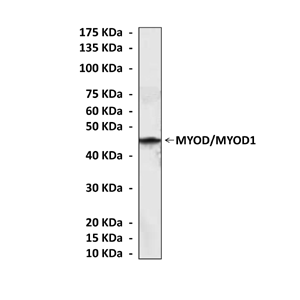Anti-MYOD/MYOD1: Mouse MYOD/MYOD1 Antibody |
 |
BACKGROUND MYOD, also known as MYOD1 ( myogenic differentiation 1) is a 45 kDa myogenic nuclear regulatory protein that belongs to the basic helix-loop-helix family of transcription factors and the myogenic factors subfamily that includes Myf-5, myogenin, MYOD1, and MRF4. These proteins share a conserved sequence motif capable of forming two amphipathic alpha helices separated by a non-helical sequence, termed helix-loop-helix proteins. In addition to the helix-loop-helix region involved in homo- or heterodimer formation, MYOD1 is characterized by a basic domain that confers DNA binding and a sequence homology with c-myc. The myogenic factors subfamily proterins are critical for skeletal muscle development.1 The role of the four myogenic regulating genes Myf-5, myogenin, MYOD1, and MRF4 (herculin, Myf.6) during mouse embryogenesis has been investigated by targeted gene inactivation. Null mutations for the MYOD1 gene generate no skeletal muscle phenotype due to a compensatory activation of the Myf-5 gene. Mice carrying a homozygous Myf-5 mutation exert considerably delayed myotome formation with unexpected consequences. While skeletal myogenesis in these mutant mice resumes normally at the onset of MYOD1 expression, a skeletal defect of the ribs persists. Apparently, Myf-5 and MYOD1 individually are not absolutely essential for skeletal muscle development, most likely because they have overlapping or redundant functions. In fact, double mutants lacking both MYOD1 and Myf.5 fail to develop skeletal musculature and the muscle forming regions seem to be devoid of myoblasts. Homozygous inactivation of the myogenin gene leads to drastically reduced myofiber formation. These mice accumulate apparently normal numbers of myoblasts which are arrested in their terminal differentiation program. Myf-6 null mutant mice exhibit drastically reduced expression of Myf-5 for reasons presently unknown. The phenotype is very similar to Myf-5 mutants with an additional reduction of deep back muscles and minor alterations in sarcomeric protein isoforms. Based on the phenotypes obtained from these various gene "knock-out" mice, we now begin to understand the regulatory network and the homostatic relationship of genes which are critically involved in myogenesis of vertebrates.2 Extensive studies have demonstrated formation of MYOD1 homodimers and heterodimers with E2A, which may be the usual cellular partner of MYOD1. The dimers bind DNA in a highly sequence specific manner as a transcriptional activator complex. Transfection of MYOD1 cDNA into a wide variety of normal and neoplastic non-muscle cells either converts them into myogenic cells or transcriptionally activates muscle-specific genes. MYOD1 appears to perform critical role in the commitment, differentiation, and maintenance of the myogenic lineage. It has been demonstrated that MYOD1 regulates muscle cell differentiation by inducing cell cycle arrest, a prerequisite for myogenic initiation. MyoD1 binds to specific promoters and ultimately leads to production of myogenic proteins such as myosin and desmin. It is also involved in muscle regeneration. MYOD1 activates its own transcription which may stabilize commitment to myogenesis. Because this DNA binding is an initial step that begins the process of myogenic differentiation, identification of MyoD1 protein potentially has great value in diagnosis of primitive tumors that are characterized by muscle development, such as rhabdomyosarcomas (RMS).3
REFERENCES
1. Dias, P. et al: Cancer Res. 52:6431-9, 1992
2. Arnold, H.H. & Braun, T.: Int. J. Dev. Biol. 40:345-63, 1996
3. Dias, P. et al: Am. J. Pathol. 137:1283-91, 1990
2. Arnold, H.H. & Braun, T.: Int. J. Dev. Biol. 40:345-63, 1996
3. Dias, P. et al: Am. J. Pathol. 137:1283-91, 1990
Products are for research use only. They are not intended for human, animal, or diagnostic applications.
Параметры
Cat.No.: | CP10313 |
Antigen: | Raised against recombinant human MYOD fragments expressed in E. coli. |
Isotype: | Mouse IgG1 |
Species & predicted species cross- reactivity ( ): | Human, Mouse, Rat |
Applications & Suggested starting dilutions:* | WB 1:1000 IP n/d IHC n/d ICC n/d FACS n/d |
Predicted Molecular Weight of protein: | 45 kDa |
Specificity/Sensitivity: | Detects endogenous MYOD proteins without cross-reactivity with other family members. |
Storage: | Store at -20°C, 4°C for frequent use. Avoid repeated freeze-thaw cycles. |
*Optimal working dilutions must be determined by end user.
Документы
Информация представлена исключительно в ознакомительных целях и ни при каких условиях не является публичной офертой








